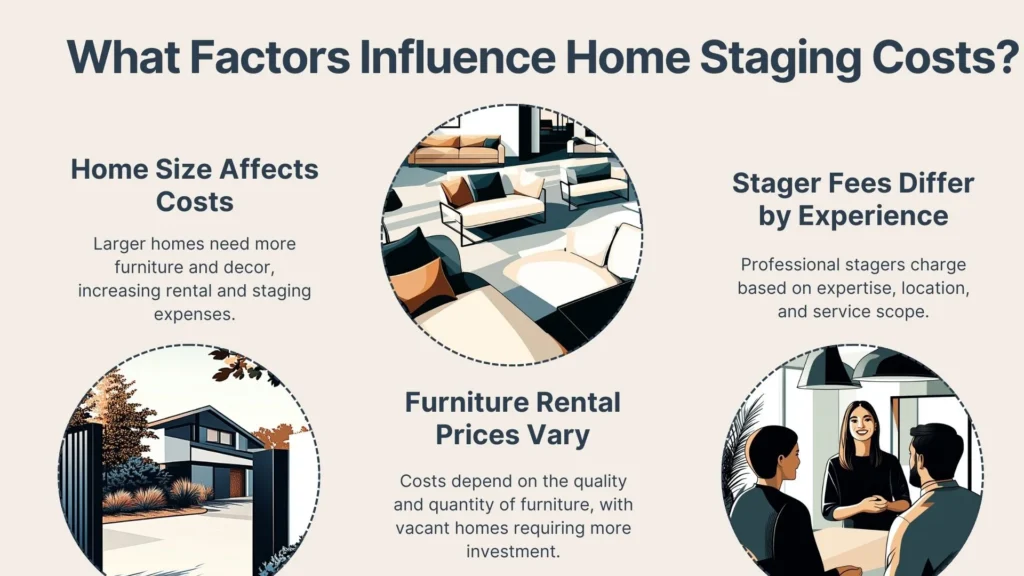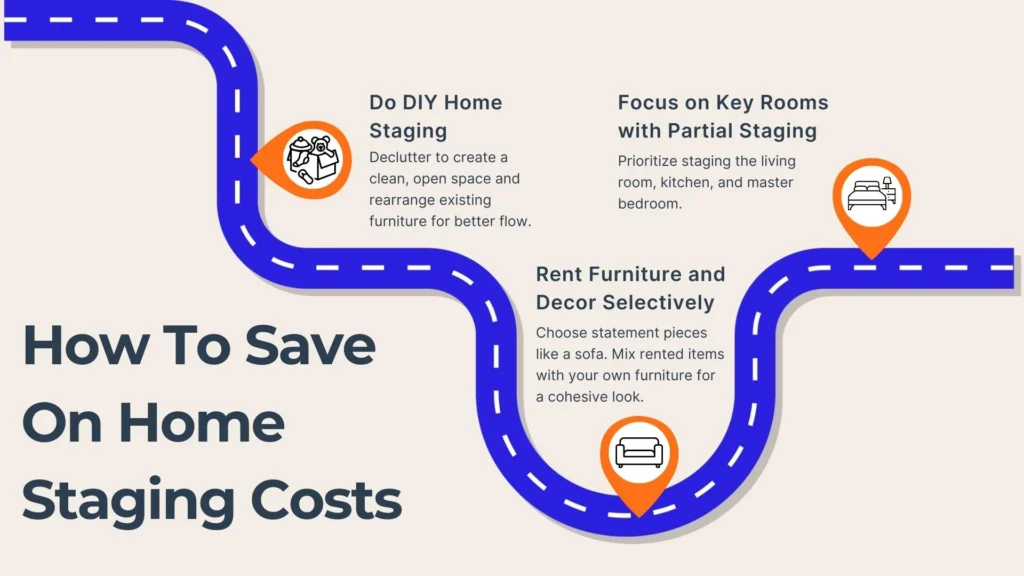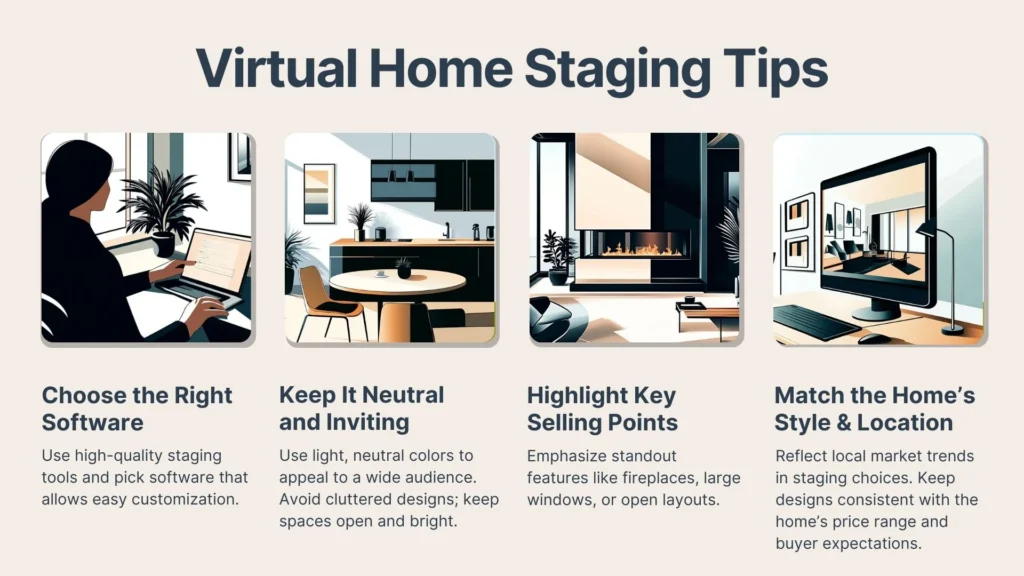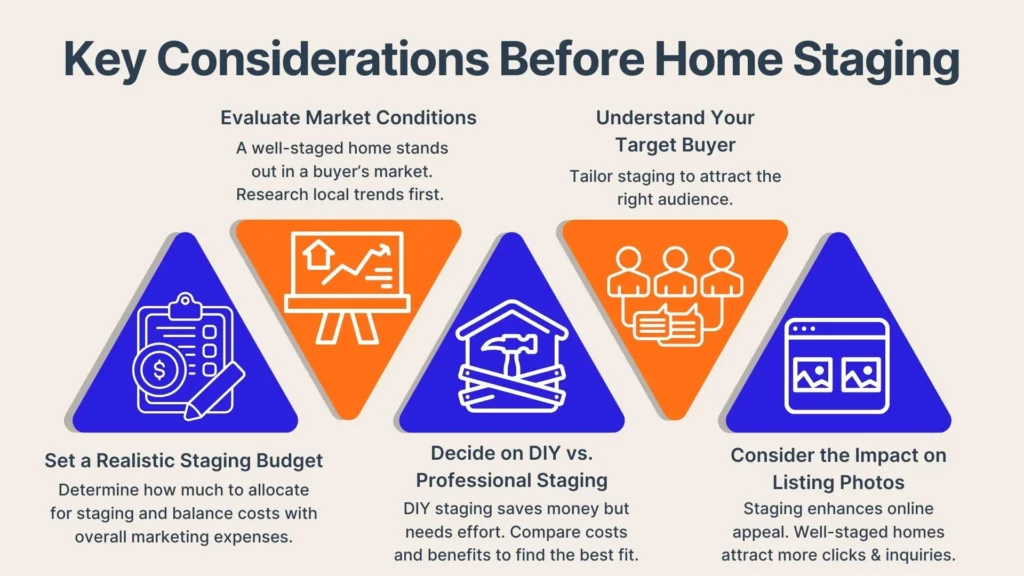First impressions matter in real estate, and a well-staged home can leave a lasting impact on buyers. Home staging has become a go-to strategy for sellers who want to stand out in a competitive market. But how much does it cost, and what are the factors that influence these expenses?
In this article, we’ll cover everything from the basics of home staging to cost-saving tips and alternatives. Read on to discover how you can enhance your home’s appeal without breaking the bank.
What Is Home Staging?
Home staging is the art of preparing a property for sale by enhancing its visual appeal and creating an inviting environment for prospective buyers. This process involves arranging furniture, adding decor, and sometimes making minor renovations to highlight the home’s best features. The goal is to make the property stand out in a competitive market and help buyers visualize themselves living in the space.
While home staging might sound similar to interior design, the key difference lies in its purpose. Interior design focuses on personalizing a space to suit the homeowner’s tastes, whereas home staging aims to depersonalize the home and make it universally appealing. This often means neutral color palettes, strategic furniture placement, and minimal clutter.
Why Is Home Staging Important?
First impressions matter in real estate, and a well-staged home can leave a lasting impact on buyers. According to studies, staged homes often sell faster and for a higher price compared to unstaged properties. This is because staging helps potential buyers see the home’s full potential rather than being distracted by empty rooms or outdated furnishings.
Home staging also plays a crucial role in online listings. In today’s digital age, buyers frequently browse properties online before scheduling in-person visits. Professionally staged and photographed homes tend to generate more interest, leading to higher foot traffic and, ultimately, better offers.
What Factors Influence Home Staging Costs?
Several elements contribute to the overall cost of home staging. These factors vary depending on the size of the property, the scope of staging, and the stager's expertise. Understanding these components can help sellers budget appropriately and determine what level of staging is suitable for their needs.

Size Of The Home Impacts Rental And Design Needs
The size of the home is a major factor in staging costs. Larger homes require more furniture, decor, and time to stage effectively. For example, a small condo might only need a few pieces to enhance its appeal, while a sprawling multi-bedroom house demands a more extensive setup.
Additionally, larger homes may require staging for multiple rooms, including bedrooms, living areas, dining spaces, and even outdoor patios. This increases not only the rental cost of furniture but also the time and labor involved in the staging process. Whole-home staging typically costs between $1,500 and $4,000.
Rental Of Furniture And Decor Varies By Quality And Quantity
Another significant expense in home staging is the rental of furniture and decor. High-end pieces can elevate the look of a home, but they come with a higher price tag. The quantity of items needed also plays a role; a fully furnished home may only need a few items, whereas a mostly vacant property might require complete furnishing.
Furniture rental for vacant homes can range from $3,000 to $6,000 or more, with monthly rental fees averaging $500 to $600 per room.
When choosing furniture and decor, it’s important to strike a balance between quality and affordability. Buyers will notice and appreciate thoughtfully curated spaces, but extravagant rentals aren’t always necessary to achieve a polished look.
Professional Stager Fees Depend On Experience And Local Rates
Hiring a professional stager is often worth the investment, but their fees can vary widely. Factors such as the stager’s experience, reputation, and the local market influence their rates. In metropolitan areas where demand for staging is high, professional fees may be higher compared to smaller towns or rural locations.
Some stagers charge a flat fee for their services, while others work on an hourly basis. Initial consultations typically cost between $150 and $600, depending on the scope of the advice provided.
How Much Does Home Staging Typically Cost?
On average, home staging costs range from $500 to $5,000, depending on the scope of the project. For example, a consultation with a professional stager might cost $100 to $300, providing sellers with actionable advice to implement on their own. Full-service staging, which includes furniture rental and design execution, can run upwards of several thousand dollars for larger homes.
To provide a clearer picture, here are some general estimates:
- Consultation only: $150 – $600
- Partial staging (key rooms): $800 – $2,500
- Full staging (entire home): $1,500 – $4,000
- Individual room staging: $300 – $700 per room
- Rearranging existing furniture: $1,000 – $3,000
- Furniture rental for vacant homes: $3,000 – $6,000+
- Monthly furniture rental: $500 – $600 per room
These costs can vary based on factors such as location, the size of the home, and the quality of furnishings. Sellers should weigh these expenses against the potential benefits of faster sales and higher offers.
How Can FSBO Sellers Save On Home Staging Costs?
For sellers choosing the For Sale By Owner (FSBO) route, managing staging costs is often a priority. Fortunately, there are several strategies to stage a home effectively without breaking the bank:

DIY Staging Tips
One of the most cost-effective ways to stage a home is to handle it yourself. Start by decluttering each room to create a clean and open environment. Rearranging existing furniture can also improve the flow of the space and highlight its best features. This approach typically costs between $1,000 and $3,000 for professional assistance, but DIY efforts can significantly reduce this expense.
Adding simple touches like fresh flowers, neutral bedding, and tasteful artwork can make a big impact. Don’t overlook curb appeal too, as a well-maintained yard and inviting entryway set the tone for the entire property.
Choosing Partial Over Full Staging
If you’re hiring a professional stager, consider opting for partial staging instead of a full-service package. Partial staging focuses on rooms with the greatest influence on buyers, such as the living room, kitchen, and master bedroom. This approach reduces costs while still showcasing the home’s most valuable spaces.
Renting Furniture And Decor Selectively
Rather than renting furniture for the entire home, prioritize select pieces for specific areas. For instance, a statement dining table or a cozy sofa can anchor a room and create a lasting impression. Combining rented items with your existing furniture is another way to cut costs while maintaining a cohesive look.
Are There Alternatives To Traditional Home Staging?
Traditional home staging isn’t the only option for sellers. Depending on your needs and budget, there are alternative approaches that can still yield impressive results.
Virtual Staging

Virtual staging uses digital tools to add furniture and decor to photos of your property. This method is particularly effective for online listings, where first impressions are often made. Virtual staging costs significantly less than traditional staging, typically ranging from $50 to $200 per room.
However, it’s important to disclose to potential buyers that the images have been digitally enhanced. While virtual staging is great for marketing, the physical appearance of the home should also be well-maintained for in-person showings.
Minimalist Staging
Minimalist staging emphasizes clean, uncluttered spaces and relies on a "less is more" philosophy. This approach works well for sellers on a tight budget or those who prefer a modern aesthetic. By focusing on a few key elements and maintaining a tidy home, you can achieve a sleek and inviting look without extensive rentals or decor.
What Should FSBO Sellers Consider Before Deciding On Home Staging?
Before committing to a staging strategy, it’s essential to evaluate your specific circumstances. Taking the time to plan can help you make informed decisions and maximize your investment.

Budget Constraints And Allocation For Marketing Expenses
Determine how much you’re willing to spend on staging and consider it as part of your overall marketing budget. Keep in mind that while staging can be an upfront expense, it often pays off in the form of a quicker sale or a higher selling price.
Target Buyer Demographic To Tailor Staging Effectively
Understanding your target audience is key to successful staging. For example, if your home is likely to attract young professionals, consider a modern and minimalist design. On the other hand, families may appreciate warm, functional spaces with plenty of storage.
Current Real Estate Market Conditions And Competition Analysis
The state of the real estate market can also influence your staging decisions. In a seller’s market with high demand, staging may not be as critical. However, in a buyer’s market, where competition is fierce, investing in staging can give your property a competitive edge.
Conclusion
Home staging is a great way to make your property more appealing and attract serious buyers. Costs vary depending on factors like home size and rental needs, but there are budget-friendly options like DIY staging, partial staging, or virtual staging.
For FSBO sellers, another way to make selling easier and more affordable is by using Propbox to stay organized and manage the home sale process. Skip the high realtor fees and get everything you need, from polished listings to virtual open houses. With AI-powered tools and a full suite of features, Propbox gives you a professional selling experience at a fraction of the cost. Sell smarter and keep more of your profits with Propbox!
